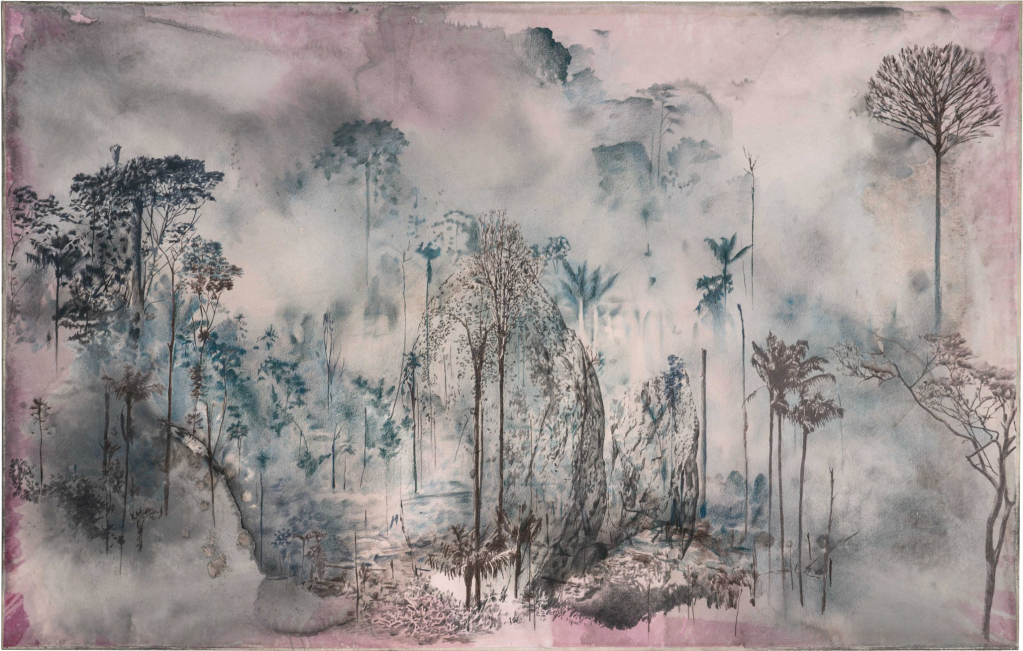Tatiana Trouvé, Untitled, 2019, from the series Les dessouvenus, pencil and bleach on paper, 60″ x 94″
Tatiana Trouvé was born in Italy in 1968 and now has settled in Paris, after having lived in Senegal as a child and the Netherlands during college (Pietropaolo 2010). She creates two-dimensional works as well as sculptures and large-scale installations that she tailors to the available space. When it comes to materials, Trouvé says she uses “a bit of everything,” including copper, leather, stone, and sand (Pietropaolo 2010). Her work often questions reality by representing objects in unexpected ways, or showing how outcomes are affected by chance or unseen influences.
One of Trouvé’s site-specific installations was created at the Migros Museum in Switzerland. It includes works like Mattress and Cushion, soft objects cast in concrete that interact with the architectural elements of the space (Rooney 2010). These pieces are an example of representing objects in a way that contradicts reality. These soft, compressible objects are transformed into something hard and immoble, floating above the ground.


Another work in the Migros Museum installation is 350 Points towards Infinity, made of “350 pendulums of all different shapes, suspended from the ceiling” (Trouvé qtd. in Pietropaolo 2010). Trouvé embedded magnets in the floor to affect the slant of the pendulums. The magnets function as an unseen force that affects the finished piece.

A more recent installation (and her first in Los Angeles) is called “On the Eve of Never Leaving.” It includes drawings from her Les dessouvenus series that are made by submerging a sheet of colored paper in bleach and using the structure created by the stains as the base for a drawing (Gagosian 2019). The finished drawing is influenced by the unpredictable ways that the paper interacted with the bleach. Another series, Great Atlas of Disorientation, uses watercolors to recreate the effect of the stains and “thus underscores the impossibility of replicating a succession of chance events” (Gagosian 2019).


Trouvé’s style often seems to be described in metaphorical terms. Rooney asks “Ever wonder what it would be like to stand on the opposite side of a force field?” and goes on to explain: “Trouvé has found a way around the progression of time, inexorably plunging the viewer into a waking dream-state” (2010). There is also a focus on the contrasts in her work. One writer describes them as “melancholy yet highly charged,” “containing echoes of other lived spaces and realities, which oscillate between the real, the imaginary, and the phantasmic” (Gagosian 2019). Rooney contextualizes Trouvé by explaining the influences she sees in some of her work, including “Superman’s arctically isolating Fortress of Solitude; the acid-gothic sculptural machinations of Banks Violette; Albrecht Dürer’s perspectivally tweaked reality; and the post-WWII asylum—all dashed with narrative overlays of Jorge Luis Borges and Jungian psychoanalysis” (2010).
More examples of her work in various galleries and installations can be found here: https://www.perrotin.com/artists/Tatiana_Trouve/28#images
Sources
2019. “Tatiana Trouvé: On the Eve of Never Leaving.” Gagosian. https://gagosian.com/exhibitions/2019/tatiana-trouve-on-the-eve-of-never-leaving/
Pietropaolo, Francesca. 2010. “In the Studio: Tatiana Trouvé.” Artnews. https://www.artnews.com/art-in-america/features/tatiana-trouv-62835/
Rooney, Kara L. 2010. “Tatiana Trouvé.” The Brooklyn Rail. https://brooklynrail.org/2010/05/artseen/tatiana-trouv
Post by Claire Benevento

Tatiana Trouvé makes art that both challenges the way we interpret our reality and provides a new line of thought. Her work posits that there are more forces at work than we can see or even fathom. The unpredictable nature of her watercolor and bleach pieces are impossible to recreate and require a new amount of creativity for each one. Her works that involve typically soft object cast in concrete contradict what our eyes tell us and confuse our perception of the textures and weights of the artwork. Our brains tell us that these objects can’t be as heavy as they appear because they are floating; yet, they are undeniably composed of this heavy substance. Trouvé’s work is unique and powerful in its ability to open our eyes to the possibilities our reality holds. -Deanna Thomas
LikeLike
I love the way Tatiana Trouvé’s work surprises the viewer. As Deanna says above, it challenges the way we interpret our reality. Looking at her work formally, the soft bleached ink contrasts beautifully with the hard lines of pencil on paper in works from the series The Great Atlas of Disorientation. Her bleach and watercolor pieces use straight dark lines to draw the eyes of the viewer across the piece. Perspective is created with more details and contrast on forms in the foreground. There is a great amount of depth and space in her two-dimensional pieces.
– Katie Reeves
LikeLike
The first thing that immediately caught my eye was the use of “bleach on paper” as a media, as I had never seen that before. However, even aside from being a pretty unique material, it fascinates me how a sterile chemical like that was used to create some pretty fascinating images of trees and nature, both transforming the chemical into the natural, while still lending some of its acrid chemical sense to the foggy, alien landscape of the piece August. A similar effect occurs in Mattress and Cushion 2, as if you hadn’t told me the objects were made of concrete I would have undeniably been tricked into assuming these were soft objects suspended on their respective pillars. This kind of transformation of materials is fascinating to me both as it trick our brains, but also as it allows for the representation of soft objects in a way that they can’t normally be permanently suspended, as we see Cushion 2 in a state of gravity-defying tension against the pillar and wall that might be impossible to maintain in a traditional soft cloth set of cushions.
Comment by Bashar Zaheer
LikeLike